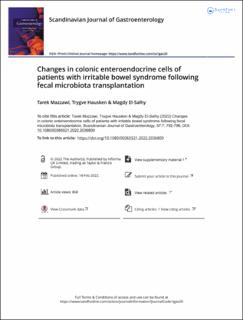| dc.contributor.author | Mazzawi, Tarek | |
| dc.contributor.author | Hausken, Trygve | |
| dc.contributor.author | El-Salhy, Magdy | |
| dc.date.accessioned | 2022-08-15T08:23:46Z | |
| dc.date.available | 2022-08-15T08:23:46Z | |
| dc.date.created | 2022-05-12T14:13:12Z | |
| dc.date.issued | 2022 | |
| dc.identifier.issn | 0036-5521 | |
| dc.identifier.uri | https://hdl.handle.net/11250/3011782 | |
| dc.description.abstract | Objectives
The aim was to investigate the effect of fecal microbiota transplantation (FMT) on colonic enteroendocrine cells densities in patients with irritable bowel syndrome (IBS).
Materials and methods
This study is connected to the REFIT study, a double-blinded placebo-controlled trial to investigate using FMT for IBS treatment. Eighty-three subjects received either donor-FMT or placebo FMT (own feces) by colonoscope to cecum. Biopsies were obtained from sigmoid colon. Ten responders and ten non-responders consented to new biopsy one-year after FMT. Sixteen patients received donor-FMT and four received placebo FMT. Biopsies were immunostained for all of the colonic enteroendocrine cells and were quantified using computerized image analysis.
Allocation sequence was revealed after obtaining re-biopsies and cells quantification.
Results
Scores for IBS-SSS (mean ± SEM) of responders (eight of 10 patients who received donor FMT) and non-responders changed from baseline to one year after FMT (297 ± 11 and 81 ± 16, p < .0001, and 270 ± 17 and 291 ± 16, p = .15, respectively). Using paired t-test to compare enteroendocrine cells densities one-year after FMT to baseline showed significant increase only in somatostatin immunoreactive cells density in the total IBS responders group (p = .023) and who received donor-FMT (p = .038). The densities of peptide YY and enteroglucagon immunoreactive cells increased significantly (p = .04 and .035, respectively) in donor-FMT recipients. No significant changes were noted in placebo FMT or nonresponders subgroups.
Conclusion
This study shows that colonic enteroendocrine cells densities significantly change in responders group that received donor-FMT. The mechanisms for the cross talks between gut microbiota and colonic enteroendocrine cells remain to be investigated. | en_US |
| dc.language.iso | eng | en_US |
| dc.publisher | Taylor & Francis | en_US |
| dc.rights | Attribution-NonCommercial-NoDerivatives 4.0 Internasjonal | * |
| dc.rights.uri | http://creativecommons.org/licenses/by-nc-nd/4.0/deed.no | * |
| dc.title | Changes in colonic enteroendocrine cells of patients with irritable bowel syndrome following fecal microbiota transplantation | en_US |
| dc.type | Journal article | en_US |
| dc.type | Peer reviewed | en_US |
| dc.description.version | publishedVersion | en_US |
| dc.rights.holder | Copyright 2022 The Author(s) | en_US |
| cristin.ispublished | true | |
| cristin.fulltext | original | |
| cristin.qualitycode | 1 | |
| dc.identifier.doi | 10.1080/00365521.2022.2036809 | |
| dc.identifier.cristin | 2023976 | |
| dc.source.journal | Scandinavian Journal of Gastroenterology | en_US |
| dc.source.pagenumber | 792-796 | en_US |
| dc.identifier.citation | Scandinavian Journal of Gastroenterology. 2022, 57 (7), 792-796. | en_US |
| dc.source.volume | 57 | en_US |
| dc.source.issue | 7 | en_US |

